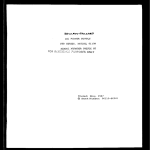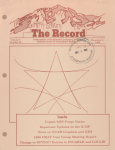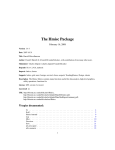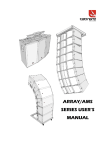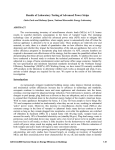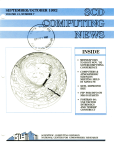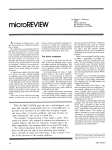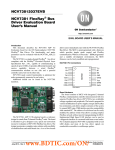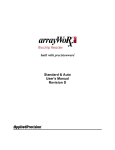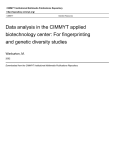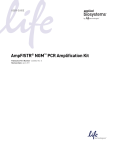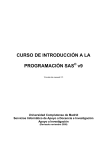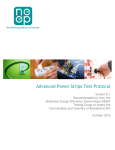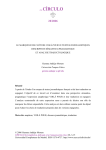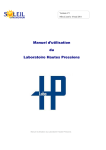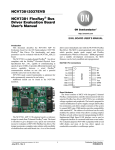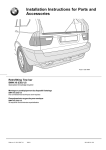Download T e Recow - Publications - University Corporation for Atmospheric
Transcript
l
1
9T
e Recow
T
A Newsletter of the Scientific Computing De"
aY 1
AtmosphericflRese1986
5 National Center for
f i.Number
s:
Volume 7
.1
90° N
-
--
A.www
r rAA
60°N
f
r
t
lr
t;'
t'.t
r
r
rr
rrr
ti
y
y
..
L
t
t
,,
1 r!!
ii#ttrrrt}t}
!
f f
1 1 r
rr t
r
rfrrf r
rir 1 tttt
rr
t t t f t
t t t f f t r
f f f
°
!
f t
f f f f
ttrtft
f
t
y+i {i t t t t
t } t t t + { + t f f
t f f t t t t t f
t f }t
rr
J'lor
t!!
}!
t f i t f
L y i
ti s ti\ 1 L i
.ti1>
"r,!
r r r r r r
rrr
rrrrrrrrrrrr
f
-
f ll +°'!a
r f
i
11titi\1
rrft
/.
rr
r
30°N
l
-.
t {
t
f f
}
41A,
30°
i
S
------..
g0° S
180°
,.,
120° W
.
y
y
L ti
--
f
AAAAr1!'
y,.
yy,
L
w w A w
ww
60° W
A w
AAAAAA
i
}
l r}
f
!}
0°
1 L L L> L L>>
i
1 L L L L\
60° E
1 i i i i
1 L L L\
1,
120° E
.ti
180°
Inside
Downtime Reminder
CRAY X-MP/48 Hardware Components
New Software: POLISH and PC Graphics Emulation
-2-
Volume 7, Number 4
April
1986
1,
SERVICES DIRECTORY
FTS prefix: 320Direct dial prefix: (303) 497NCAR Operator: (303) 497-1000
Consulting Office: (303) 497-1278
r_
T
Cicely Ridley
John Adams
Rosemary Mitchell
Sal Farfan
extension
1211
1213
1235
1292
room #
119
118
5
17G
REMOTE USER INFORMATION
Data Communications (RJE)
US Telecom (UNINET)
RJE Password Assignment
Visitor Information
Bill Ragin
Marla Sparn
Rosemary Mitchell
Kathy Lucero
1258
1301
1235
1231
11C
100
5
6
OPERATIONAL INFORMATION
Computer Operations
Machine Room
Graphics Operations
Bob Niffenegger
Oper. Supervisor
Andy Robertson
1240
1200
1241
1242
1245
1232
1310
1245
1245
7
29
31E
NEW USER INFORMATION
Computing Resource Applications
Project & User Number Assignment
Document & Manual Distribution
Send electronic mail using
TO SAL on the IBM 4341
1/2" Tape Librarian
TBM Tape Librarian
Software Distribution
Output Mailing
I
Sue Long
Mary Trembour
Belinda Housewright
Sue Long
Sue Long,
.
.
6A
5
6
6A
6A
_
SCHEDULE OF MACHINE UNAVAILABILITY
All machines may be down from 07:00 until 08:30 daily for Systems Checkout.
In addition, some machines will be down for Preventive Maintenance as follows:
CRAY,C1
CRAY,CA
TBM
06:00-08:00
06:00-08:00
06:00-07:00
Monday & Wednesday
Tuesday & Thursday
Daily
The Record is published monthly by the Scientific Computing Division of the National
Center for Atmospheric Research. NCAR is operated by the University Corporation
for Atmospheric Research and is sponsored by the National Science Foundation.
Reference to a company or product name does not imply approval or recommendation
of that company or product to the exclusion of others.
Robert Nicol, Editor
Ann Cowley, Head, Information Services
Ken Hansen, Trouble/Design Reports
Ken Walton, Summary of NCAR Computer Use
JoAnn Knudson, Computer Resources Allocated
The Record
Volume 7, Number 4
April 1, 1986
-3-
Table of Contents
Features
...........
4
Extended Downtime Period Scheduled for May and June ......................
The CRAY X-MP/48 - Hardware Components .............................................
4
Consulting Office Schedule
........................................... ...
4
Software News
8
A CRAY Software Tools at NCAR A .....................................................
.................................
9
MicroNews - The PC Graphics Emulator EM4010 ..................................
11
..........................................
14
...............
The FORTRAN 77 POLISH Utility
For The Record
TBM Mass Storage News
Computing Resources Earmarked for Oceanography
SCD Advisory Panel Meeting Schedule
ZOT - Final TBM Purge
......
..........................
.............................................
....
Minutes of the SCD Users Group Meeting
................
..............
16
.............
16
..............
20
.................
Summary of Daily Bulletin Items ......................
Computer Resource Allocations ...............
Summary of NCAR Computer Use .............
Trouble/Design Report: CRAY 152
15
16
.............................
Documentation Update ................
15
..............................
24
............................
25
..................................
.............
26
Cover Graphic
The graphic on the cover of this issue was produced by Grant Branstator of the Atmospheric
Analysis and Prediction Division, and was originally published in The Journal of Atmospheric
Science, Vol. 42, November 1, 1985. The data were the result of a representation of the solution of a theoretical model. Grant modelled the influence of a warm surface temperature anomaly on atmospheric flow over the entire globe. The shaded area at the left represents the
warm temperature anomalies; the arrows indicate the direction of energy propagation; and the
contour lines represent the magnitude of response to the anomaly. Grant produced this plot
using the CONREC and VALVCT routines in the NCAR Graphics Package, and produced the
labels with a routine written by Robert Chervin (AAP) that uses PWRX.
metacode was processed on the DICOMED film processor.
The graphics
Software Change Articles
All articles about changes to software which affect the computing environment are now flagged
with the triple Delta insignia, as shown in the example below.
Example of a Software Change Article Title
by An Author
The Record
-4-
Volume 7, Number 5
May
1,
1986
Consulting Office Schedule for May 1986
The Consulting Office will not have a regular schedule during May. Due to the
extended shutdown of the Machine Room scheduled to begin May 3 (see item below), the Consulting Office will not adhere to a regular schedule during most of May. Consultants will be
available for several days following the shutdown; thereafter, calls will be handled by any available consultant or will be forwarded to the Consulting Office answering machine. Contact the
Consulting Office at (303) 497-1278.
Extended Downtime Period Scheduled for May and June
This is a reminder that the SCD Machine Room at the Mesa Laboratory will be shut down for
an extended period to complete site preparation for the CRAY X-MP/48 and to perform muchneeded upgrades to the power supply and distribution equipment. The current estimate of the
shutdown schedule is for the period from Saturday, May 3 to Monday, June 2. However,
please note that the schedule may change due to variations in equipment supplies and contractor workloads.
The CRAY X-MP/48 -
Hardware Components
by Richard K. Sato
The major hardware components of the CRAY X-MP (scheduled for delivery to NCAR in
August of this year) were briefly discussed in the March issue of The Record. Three of these
components will allow users to attempt to solve problems that could not be attempted on a
GRAY-1 machine. These components are:
" The Central Processing Units (CPUs)
" The Solid-state Storage Device (SSD)
" The Central Memory (CM)
This article discusses these components, with an emphasis on central memory and memory bank
conflicts.
The Central Processing Units
The GRAY X-MP will include four CPUs controlled by the GRAY Operating System (COS).
Each CPU is architecturally similar to that of a GRAY-1 computer; however, each provides
more processing power than a GRAY-i because of two major differences: first, the cycle time of
the GRAY X-MP is 9.5 nanoseconds, as compared to the 12.5 nanosecond GRAY-1 cycle time;
second, each CPU on the GRAY X-MP has four paths to memory, rather than the single path
on a CRAY-1. Both enhancements will result in better performance for jobs (less CPU time
consumed) when run on the GRAY X-MP.
The Record
Volume 7, Number 5
-5-
May
1,
1986
Your existing jobs can run on the CRAY X-MP in single-processor (serial) mode. This means
that only one physical CPU will be executing your program at any instant in time, although the
operating system may schedule job execution on different physical CPUs during the execution of
the job. Codes can be modified to execute on multiple CPUs in parallel by implementing CRAY
multitasking primitives or microtasking directives. (Documentation on details of implementing
multitasking will be available at a later date.)
The Solid-state Storage Device
The Solid-state Storage Device (SSD) is a new component, since no corresponding facility is
available on a CRAY-1 machine. The NCAR CRAY X-MP SSD will have a capacity of 128 million CRAY 64-bit words. Physically, the SSD is similar to central memory, in that it provides
temporary, volatile, random-access storage for 64-bit words with 8-bit Single-Error Correction,
Double-Error Detection (SECDED) logic, using solid-state, Emitter-Coupled Logic (ECL) technology.
From a user viewpoint, the SSD acts as a very fast disk. Datasets are defined by the ASSIGN
JCL command in the same way as disk files, and are assigned to the SSD by specifying an additional parameter on the ASSIGN statement. Data transfers to and from these datasets are
accomplished by the same read and write statements used for accessing disk files.
The access time for the SSD is about 50 microseconds (compared with 20 milliseconds for the
DD49 disks) and the transfer rate to central memory is about 1 gigabyte per second (compared
with 10 megabytes per second for DD49 disks). The SSD is an ideal component for storing temporary datasets that are heavily accessed. The I/O wait time can be reduced from hours to
minutes or from minutes to seconds. However, system management of the SSD presents some
problems. Currently, a job's SSD image is not "rolled out" to disk as is the job's central
memory image. Therefore, once a job is allocated SSD space, it retains the space until it terminates. The data is also vulnerable to loss due to power failures, since the SSD is a volatile
storage media. These drawbacks will limit the usefulness of the SSD, particularly for longer
running jobs, perhaps running at a lower priority. Unfortunately, these are the jobs that might
benefit the most from using the SSD. Strategies for management of the SSD are being investigated.
Central Memory
The CRAY X-MP will have 8 million 64-bit words of ECL memory, which is 8 times the
amount of memory available on the CRAY-1A machines. As on the CRAY-1 computers, each
word includes an additional 8 bits for SECDED logic. The performance of the CRAY X-MP, as
well as the CRAY-1 machines, is decreased because of memory bank conflicts. However, the
effect of the conflicts may be more noticeable on the CRAY X-MP, because conflicts between
jobs can occur and cause a job's execution times to vary from run to run. The remainder of this
article includes a description of central memory and an explanation of memory bank conflicts.
Memory Organization
Central memory is organized into banks, which consist of one million bytes of memory. The 8
million words of CM of NCAR's CRAY X-MP is therefore in 64 banks. The banks are further
grouped into 4 sections, which consist of 16 banks.
The Record
Volume 7, Number 5
-6-
Section
Banks (numbers in octal)
0
0-3, 20-23, 40-43, 60-63
1
4-7, 24-27, 44-47, 64-67
2
10-13, 30-33, 50-53, 70-73
3
14-17, 34-37, 53-57, 74-77
May
1,
1986
There is an independent data path from each CPU to each of the 4 sections of memory. This
organization allows up to 16 memory references per Clock Period (CP).
Memory Access Conflicts
A memory reference cycle requires 4 CPs. That is, a request to a memory bank will take 4 CPs
to complete and therefore a subsequent request for a word from the same bank will be held until
the current request is completed.
A memory bank conflict occurs when a request to a busy bank is issued. The request will be
delayed from 1 to 3 CPs for the previous request to complete. A memory bank conflict is one of
three types of memory access conflicts:
1. Busy bank conflicts are caused by any port within or between CPUs requesting a bank
that is currently in a reference cycle (a memory bank conflict).
2. Simultaneous bank conflicts are caused by two or more ports in different CPUs requesting the same bank.
3. Section access conflicts are caused by two or more ports in the same CPU requesting any
bank in the same section.
Layout of Words in Memory
Consecutive addresses in memory are assigned to consecutive banks. For example, an array A()
is stored in consecutive words in memory so that if A(I) is in bank n then A(I+1) will be in
bank n+1. Storage of a two dimensional array is by columns. For example for an array
declared as
DIMENSION A(64,n)
is stored as follows:
The Record
-7-
Volume 7, Number 5
May
1,
1986
Storage of A(64,n) in Central Memory
A(i,j)
Bank
0
1,1
1,2
..
..
1,n
1
2,1
2,2
..
..
2,n
2
3,1
3,2
..
..
3,n
31
32,1
32,2
..
..
32,n
63
64,1
64,2
..
..
64,n
If A is accessed by columns, then there are no memory access conflicts. However, because the
first dimension of A is 64, then all elements of a given row will be stored in the same bank.
Therefore, when A is accessed by row, access of each element of the row will result in a memory
bank conflict, and the transfer rate from memory will be one element every 4 CPs rather than
the rate of 1 element per CP when accessed by columns. This problem can be eliminated by
specifying
DIMENSION A(65, n)
which may result in unused memory space, but will improve performance. A first dimension of
a multi-dimensional array of 32, 64, or 128 should be avoided.
You can eliminate or minimize memory conflicts within your programs by specifying appropriate
DIMENSION statements. However, since the CM is shared by all CPUs, memory access
conflicts between jobs on different CPUs can occur. You will have no control over these
conflicts. You should be aware that execution times of the same job may vary from run to run
because of memory access conflicts.
The compatibility between the CRAY X-MP and the CRAY-1 computers will allow an easy
transfer of jobs from the CRAY-1 machines to the CRAY X-MP. New features on the CRAY
X-MP may require some changes in modes of operation but these features will provide a substantial increment in computing resources available for NCAR users.
Richard Sato, of SCD'S Advanced Methods Section, is handling user trainingfor the CRAYX-MP system.
The Record
-8-
Volume 7, Number 5
May
1,
1986
CRAY Software Tools at NCAR
by Dick Valent
The NCAR Software and Libraries Group (SLG) has supported a local version of the Software
Tools on NCAR's CRAY machines for more than three years. These tools and associated utility
routines originally were developed by Brian Kernighan and P.J. Plauger, as documented in their
book Software Tools, and later were brought up on NCAR's CRAY machines by SCD staff
members. With the installation of COS 1.14, a CRAY-supported version of the Software Tools
is now available.
Accordingly, the local version of the Tools supported by SLG will be replaced on June 18, 1986
in deference to the CRAY version. Until then, users may access the local Tools by including
CRAY procedure LTOOLS (formerly called TOOLS) in their JCL prior to the first Tools usage.
However, users are strongly encouraged to change their jobs to the CRAY version as quickly as
possible, by using the following JCL template:
CTOOLS.
SH.
EXIT.
\EOF
... your Tools commands go here ...
... COS JCL can be mixed with Tools commands ...
\EOF
You can order The CRAY Software Tools Reference Manual 1.14 (SR-0010-01) for $3.75 and
The Software Tools ProgrammersManual (SN-0226) for $24.00 by contacting
Teresa Homan
CRAY Central Region Office
5350 Manhattan Drive
Boulder, Colorado
USA
80303
Telephone: (303) 499-3055
Please make checks payable to Cray Research, Inc. Also, please note that Manual SR-0010
incorrectly indicates that SN-0226 is available on-line.
Please direct questions to CRAY Software Librarian Dick Valent at (303) 497-1302.
Dick Valent is a CRAY Software Librarian in the User Services Section of SCD.
The Record
-9-
Volume 7, Number 5
May
1,
1986
The FORTRAN 77 POLISH Utility
by Dick Valent
Editor's Note: This article is a reprint of the Consulting Office document on the FORTRAN
77 POLISH utility; it is reproduced in the format used for SCD documentation. The full text is
available from Sal Farfan, SCD Documentation Specialist. Contact him at (303) 497-1292, or
send electronic mail TO SAL on the IBM 4341 system.
INTRODUCTION
Over the past four years, the NCAR Software and Libraries Group has
received many requests for a utility that beautifies or "polishes" FORTRAN 77 code. The POLISH utility was acquired and installed on
NCAR's CRAY-1 machines to satisfy this need. In particular, POLISH
provides indentation of control structures, systematic token spacing,
systematic labelling, and line identification.
You can obtain a copy of The POLISH 77 User's Guide by contacting
Sal Farfan at (303) 497-1292. Please direct questions to CRAY
Software Librarian Dick Valent at (303) 497-1302.
LATEST
REVISION
March 1986
PURPOSE
To visually beautify and enhance readability of programs written in
FORTRAN 77.
USAGE
POLISH is supported at NCAR on the CRAY machines only. Input
consists of a local dataset containing FORTRAN 77 source code, and
optional values for the POLISH formatting features. Output consists
of an error dataset and a dataset containing the polished code.
You can use POLISH by specifying the following CRAY-1 command:
POLISH, TEXTIN=textin, TEXTOUT=textout, ERR=err, ^
LMARGS=lmargs, RMARGS=rmargs, LMARGC=lmargc,
INDNTS=indnts, INDNTC=indntc, MOVESF=movesf, ^
LABELS=labels, IDENTL=identl, KCMMNT=kcmmnt, ^
MCMMNT=mcmmnt.
PARAMETERS
ON INPUT
TEXTIN--textin
CRAY local dataset containing FORTRAN 77 code to be polished.
Each invocation of POLISH processes one file of dataset textin. If
TEXTIN-$IN, the current file of $IN is polished. Otherwise, only the
first file of textin is polished. Default value is $IN.
TEXTOUT--textout
CRAY local dataset containing polished code resulting from POLISH
operating on TEXTIN=textin. If TEXTOUT=$OUT, the polished
code is appended to $OUT. Otherwise, the dataset textout is rewound
before being written. Default value is $OUT.
ERR=err
CRAY local dataset containing errors flagged by POLISH. If
TEXTOUT=$OUT the error messages are appended to $OUT,
The Record
Volume 7, Number 5
-10-
May
1,
1986
otherwise dataset err is rewound before being written. If dataset err is
not $OUT, then it must be different than textout also. Default value is
$OUT.
LMARGS=lmargs
Left margin for statements. Default value is 7.
RMARGS=rmargs
Right margin for statements. Default value is 71.
LMARGC=lmargc
Left margin for comments. Default is 3.
INDNTS=indnts
Indentation for statement lines. Default value is 2.
INDNTC=--indntc
Indentation for comment lines. Default value is 2.
MOVESF--movesf
Move format statements to end of program unit. MOVESF=O means
do not move format statements. MOVESF--1 means move format
statements. Default value is 0.
LABELS=--labels
Value of first label and of the label increment. LABELS--0 means do
not change labels. Default value is 10.
IDENTL=--identl
Fill identification field with line number and abbreviated unit name.
IDENTL--0 means leave identification field blank. IDENTL=1 means
fill in identification field. Default value is 1.
KCMMNT=kcmmnt
Parameter controlling display form of comments. Possible values are 1
through 6. 1: dashes precede text of indented comment lines. 2: asterisks precede text of indented comment lines. 3: half box of asterisks
drawn around comment block. 4: full box of asterisks drawn around
comment block. 5: if the first character of the text of a comment
block is preceded by a right parenthesis then draw a full box around
the block; otherwise precede the text of an indented comment line with
asterisks. 6: leave comment lines alone. Default value is 5.
MCMMNT=mcmmnt
Parameter controlling interpretation of start of comment line. Possible values are 0 through 2. 0: discard leading blanks on a comment
line. 1: the first non-blank character on a comment line is a flag marking the start of the comment line. 2: do not discard leading blanks on
a comment line. Default value is 2.
SPECIAL
CONDITIONS
POLISH diagnostics are not specific when FORTRAN 77 standards are
violated. Scan or fatal errors are written to the error dataset indicating the vicinity of the error. CRAY users are advised to pass their
FORTRAN 77 code through CFT with option ANSI to help them
locate 77 violations.
LANGUAGE
POLISH is a FORTRAN 77 code supported with a CRAY JCL user
interface.
HISTORY
This version of POLISH was given to NCAR by the National Bureau of
Standards in Boulder, Colorado in January 1986. POLISH was
brought to NCAR by the SCD Software and Libraries Group in
response to user requests for this utility.
PORTABILITY
Since POLISH is written in FORTRAN 77, it is very portable.
Dick Valent is a CRAY Software Librarian in the User Services Section of SCD.
The Record
Volume 7, Number 5
-11-
May
1,
1986
MicroNews
The PC Graphics Emulator EM4010
by Harsh Anand Passi
Introduction
In a recent meeting, representatives from several divisions at NCAR discussed the merits of
various Terminal Emulation software packages. Several desirable features were specified, and
with those in mind, the following three software packages were selected as candidates for
evaluation.
After investigating relative merits of the proposed packages, we found that the EM4010 package, from Diversified Computer Systems (DCS), outperformed the others with regard to cost,
documentation, level of support, extended software features, ease of use, and so on. For both
ASCII and graphics terminal emulation on the IBM PC and compatible machines, we found
EM4010 software quite adequate. SCD's User Services Section staff have been evaluating various versions of this software for some time. While early versions had a few bugs, the latest
release has performed well. Its salient features are given below.
Salient Features of the EM4010 Software Package
EM4010 is a menu-driven terminal emulator, which converts an IBM (or compatible) PC into a
Tektronics 4010/4014 graphics terminal. It can also be used as a VT220, VT102, VT52, or
VT100 terminal with a variety of minicomputers and mainframes, including IBM 4341 computers, UNIX M systems, DEC VAX computers, and others. The PC is connected to the host computer directly or by an autodial modem. The EM4010 emulates most features of the VT220 terminal (see the EM220 Product Description, Reference [2] of the three references listed at the end
of this article). In addition to the standard VT220 features, EM4010 offers many other
extended features. Among these are:
-
Split screen horizontal scrolling
Programmable scroll rate
-
Screen scroll back
-
DOS Hot Key support
-
Color support
-
Command files
Automatic modem dialer
-
Phone directory
-
Data logging and replay
-
On-line help
-
Unlimited set up configurations
-
Easy-to-use file transfer capability between the PC and host computer system
The Record
-12-
Volume 7, Number 5
May
1,
1986
The package is very well documented and is easy to set up. This emulation software permits the
capture of graphics display to disk files for later screen copying or making hard copies on the
printer or plotter (see [2] for further details).
PC Setup for EM4010 Emulation
A.
Hardware and Software Requirements
The following hardware and software are required to use the EM4010 software:
An IBM PC, XT, AT, or compatible model with one disk drive
" One serial port
" One of the following graphics boards:
IBM standard color
IBM Enhanced color
Hercules Monochrome
Tecmar Graphics Master
AT&T 6300
Or any graphics card compatible
with one of the above,
" 256K of memory,
" DOS version 2.0 or higher,
" Optional: printer and/or plotters (see [2] for the list of printers and plotters supported by EM4010)
B.
Emulator Menu Editing
This software package has several default setup configuration files for multiple host systems that may need to be modified. These modifications include setting the communication parameters in the Main Setup Menu, setting the keyboard options in the Keyboard
Setup Menu, configuring several emulator features that are not standard VT220 options in
the Special Setup Menu, and so on.
C.
Graphics Display on the IBM4341
To peruse the graphical display on the screen of metacode files, log onto your virtual
machine on the IBM 4341 system. Use PLT EXEC from NCARLIBS by entering the command
PLT <filename> <filetype> <filemode> <RETURN>
where <filename>
prompt
<filetype>
<filemode> is the metacode file. On receiving the
<ENTER>
specify the GRAPHCAP file by typing
The Record
Volume 7, Number 5
-13-
May
1,
1986
Specify EM <RETURN>
This will be followed by the prompt message:
EM GRAPHCAP K HAS BEEN SELECTED
<ENTER>
Then enter PLT legal response to the <ENTER> prompt to examine individual frames
from a plot file.
Availability
This software is distributed by DCS. A diskette containing the package and documentation can
be purchased from:
Diversified Computer Systems
3775 Iris Avenue, Suite 1B
Boulder, Colorado 80301
The software is discount priced at $60.00 for customers belonging to academic or nonprofit
organizations affiliated with NCAR. Major revisions will be supplied free to all persons purchasing EM4010 within 90 days of the update release date. Updates for users who purchased
EM4010 more than 90 days before the new release date will be required to pay a small fee, not
to exceed $35.00.
User Support
DCS has a toll free support number for technical support and provides help for emulator related
questions. For assistance call
800-621-8385, Extension 484
For more information, contact Ken Hansen at (303) 497-1294 or Harsh Anand Passi at (303)
497-1285, or send electronic mail on the IBM 4341 system to HANSEN or HARSH, respectively.
References
[1] EM220 Product Description, Diversified Computer Systems
[2] EM4010 Product Description, Diversified Computer Systems
[3] EM4010 User Manual, Diversified Computer Systems
Harsh Anand Passi is a programmer and consultant in the User Services Section of SCD.
The Record
-14-
Volume 7, Number 5
May
1,
1986
TBM Mass Storage News
As announced in the letter sent to all SCD computer users, the TBM will be set to read-only
status on July 1, 1986. All datasets created after that date must be sent to the new Mass
Storage System (MSS) for permanent storage. In addition, you should note the following information about dataset purges:
* The TBM dataset purge scheduled for May 3, 1986 has been cancelled.
purge in May.
There will be no
* The next and final purge of TBM datasets will take place on June 28. This purge will
delete all datasets not accessed since June 1, 1986. Note that the retention period for
this purge is 28 days, rather than the 90 day period used in the past.
* No purges of TBM datasets are scheduled after June 28, since no data will be added to the
TBM after July 1.
Operations staff are currently transferring data from Dedicated TBM reels to the new MSS.
After the TBM is set to read-only status on July 1, Operations staff will begin transferring data
from Production tapes to the new MSS. It is imperative that you delete any data that
you have already transferred to the new MSS. In addition, we urgently request that
you delete any TBM datasets that you do not wish to keep, or allow them to be
purged by not updating them after June 1.
Mary Trembour, (303) 497-1232
and
Sue Long, (303) 497-1245
are SCD's Tape Librarians. They will be more than happy to provide you with assistance or
delete the data for you. Please call them or send your list of datasets to be deleted as soon as
possible.
Transferring the enormous amounts of data on the TBM to the new MSS is a huge, timeconsuming task. Any help that you can give by eliminating your unneeded datasets is greatly
appreciated. Thank you for your valuable assistance.
Mass Storage System Users
Please note the following information concerning dedicated media on the new Mass Storage Sys-
tem:
* There is no exact equivalent to TBM Dedicated tape reels on the MSS. There are virtual
volumes or private files, but these are NOT the same as Dedicated reels on the TBM.
* Virtual volumes are subject to regular purges on the MSS. The only advantage to
using a virtual volume is the longer default retention time (367 days) and the greater maximum retention time (4095 days).
Further information on virtual volumes is available in the Consulting Office document entitled
The Mass Storage System (see the Documentation Update column). Please consider the points
noted above in determining whether assignment of a virtual volume will answer your data
storage needs.
The Record
Volume 7, Number 5
-15-
May
1,
1986
Computing Resources Earmarked for Oceanography
Starting in September, 1986, the computing power of the Scientific Computing Division will be
enhanced by a CRAY X-MP/4800 in addition to one CRAY-1A. By agreement with the
National Science Foundation, up to 20 percent of the available computing resources are earmarked for university research in oceanography. Support, no longer limited to physical
oceanography, will be extended to include all areas of basic oceanographic research. SCD looks
forward to serving these new users and urges them to submit their requests for computing support in readiness for the resources that will become available in the Fall.
All requests for SCD computing resources are subject to peer review. Allocations of up to five
hours of CPU time on the CRAY-1A or the CRAY X-MP/4800 are made by the Director of
SCD and can be processed at any time. Larger requests are reviewed by the SCD Advisory
Panel, which meets twice a year; the next meeting is September 29-30, 1986. Requests for
review must be submitted to SCD by July 24, 1986. Projects sponsored by the National Science
Foundation receive computing resources free of charge. All other projects are subject to charges
for resources used.
For information on SCD's computing resources and services, and about application and evaluation procedures, contact:
Ms. Betty Thompson
Assistant Administrator
Scientific Computing Division
National Center for Atmospheric Research
P.O. Box 3000
Boulder, CO 80307-3000
Telephone: (303) 497-1208 FTS: 320-1208
SCD Advisory Panel Meeting Schedule
With the advent of the CRAY X-MP/4800, SCD's computing power will be enhanced by a factor of at least five. It is expected that the new machine will become available to users in early
Fall 1986, so now is the time to think about those big projects that have been waiting on the
back burner because of lack of computing resources.
Requests for a total of more than five hours of central processor time on the CRAY-1A or the
CRAY X-MP/4800 computers must be considered by the SCD Advisory Panel, which will meet
September 29-30, 1988. University users must submit large requests to John Adams or Cicely
Ridley of the Scientific Computing Division by July 24, 1986. Nine to ten weeks are needed for
the preliminary review of requests and for the preparation, printing and distribution of Panel
materials.
The Record
Volume 7, Number 5
-16-
May'
1,
1986
ZOT - The Final TBM Purge will occur on June 28, 1986
As noted in the TBM Mass Storage News column above, the TBM purge scheduled for May 3
has been cancelled. The final purge of datasets from the TBM will occur on June 28, 1986.
The retention period has been reduced to one month for this purge, so it will affect all datasets
not accessed since June 1, 1986.
Documentation Update
The purpose of this column is to announce revisions, updates and new documents of interest to
the user of SCD's computers. Included at various times will be documents issued by SCD, by
NCAR but outside SCD, by IBM, and by Cray Research, Inc. Directions for obtaining the
documents are included.
Please note that manuals ordered from SCD will take approximately two weeks to reach you.
SCD Documents
SCD documents are available from Sal Farfan; contact him at (303) 497-1292 or via electronic
mail by typing "TO SAL" on the IBM 4341 system.
The following Consulting Office documents are now available:
An Introduction to Using SAS on NCAR's IBM 4341 Computers, by Ginger Caldwell, Revised:
February 1986.
MOV2MS: A Utility for Moving PSTORE Files to the New Mass Storage System, by Michael
Pernice, March 1986.
Using POLISH on the NCAR CRA Y Computers, by Richard A. Valent, March 1986.
Collected Algorithms of the ACM 1975-1979 and 1980-1985, by Michael Pernice, April 1986.
User Services Mass Storage System Software, by Herb Poppe, April 1986.
Minutes of the SCD Users Group Meeting
March 31, 1986
Chairman Ray Bovet called the meeting to order and asked for corrections or additions to the
February meeting minutes. The minutes were accepted as written.
Report from SCD Director Walter Macintyre
Walter said that the FY86 budget was finalized two weeks ago, and there are no major effects
on SCD operations. As a consequence of the budget cuts, SCD has lost 14 new positions
authorized for the expansion of operations. This means that the CRAY X-MP/48 will not be
integrated as efficiently as SCD would like.
The Record
Volume 7, Number 5
17-
May
1,
1986
The physical plant work underway in preparation for installation of the CRAY X-MP/48 is
proceeding on schedule. Two weeks of "buffer time" remain for last minute crises. Walter
explained the details of the work planned during the shutdown of the Machine Room, scheduled
from May 5 through June 3. He said that the shutdown could extend beyond June 3 if it is not
started on time or if there are problems. Gary Jensen, Head of the SCD Operations Section,
said that there is a possibility that the shutdown could be shorter because some of the work has
been cancelled, but this is uncertain. Some air conditioning equipment was removed during the
recent 4-day shutdown. Planning to keep the PACX, SCD's terminal switching and port contention device, is underway, but feasibility is uncertain. [Editor's Note: Since this meeting,
Physical Facilities has informed SCD that the PACX should be in operation for much of the
scheduled downtime. However, it is likely that the PACX will have to be shut down for limited
periods during work on the power supply equipment. In addition, unseasonably hot weather
may interfere with temporary cooling measures, which would also force a shutdown. Users can
anticipate that the PACX will be available, aside from these exceptions.]
Walter said that the CRAY,C1 machine (Serial X14) will be shut down at the end of July. The
TBM will be decommissioned at the end of the fiscal year, on September 30. SCD is trying to
obtain funding outside of the National Science Foundation to keep the TBM in operation past
September 30, in order to transfer valuable satellite data from NOAA/NESS tapes.
The new disks for the Mass Storage System (MSS) and the new front-end computer for the
CRAY X-MP/48 are expected to be installed by early summer. The disks will provide more
on-line storage capacity. At that point, the TBM will be set to read-only status.
Consideration is being given to plans for establishing a Communications Section within SCD.
Margaret Drake is chairing a committee, which will decide how this can best be accomplished.
Communications has become increasingly important to the operation of SCD over the last
several years and will become even more important in the future.
The USAN satellite experiment will be completed in September of 1987, and it is expected that
the prototype will evolve into a national, broad-band scientific data communications network.
Carl Mohr (CSD) asked which machine was being used as a gateway for the satellite link.
Walter replied that a Sun supermicro workstation is the current candidate; one of SCD's Sun
machines is now linked into the NCAR Local Area Network (NLAN). In the original plans, the
SCD Pyramid super-minicomputer was to be used; however, it has been extremely difficult to
establish a stable link between the Pyramid and the NLAN.
Carl asked what would happen when the link is established between the USAN network and the
NLAN, and more people begin to use the link. Walter said that a stand-alone machine to be
used as a gateway will have to be procured by OASC funding. SCD had hoped to use one of
the IBM 4341 machines as the gateway, but the necessary software is not available. A proposal
to OASC is now being prepared and will be submitted at the proper time. Carl asked if the
users at 30th Street would be able to use this as a gateway machine with the same software;
Walter confirmed this.
Ray asked about the dates of the shutdown. Gary Jensen said that it is tentatively scheduled
from May 5 to June 4, but it will be another week before the contractor establishes that he can
begin on May 5. There could be a delay of a few days. Ray expressed concern about the unavailability of the PACX during the shutdown, and Gary said that it is still not clear how they
will get the power to the PACX. He said to contact George Lamb for a firm answer.
The Record
Volume 7, Number 5
-18-
May
1,
1986
Ray also asked about the Gilman Committee, which is evaluating the role of computing in the
atmospheric sciences; Walter replied that the committee is under the direction of UCAR, and
reports to Cliff Murino, President of UCAR.
Walter announced hat this would be his last meeting, since he is retiring as Director of SCD; he
said that he has enjoyed his six years at NCAR and he thanked the SCDUG members for their
contributions to the success of the computing enterprise.
Report from the X-MP/48 Integration Task Force - Bob Lackman
Bob Lackman, chairing the Task Force, said that members met on March 7. A report was submitted from each of the four subcommittees (Training, Software, Charging, and File Management). A comprehensive set of minutes is available in the Computing Library, located next
door to the Consulting Office. The minutes are kept on the top shelf in a notebook labeled "XMP". Bob then gave a short summary of the March 7 meeting.
Regarding training: Dick Sato has been giving a series of seminars on CRAY X-MP topics; the
next seminar will be held April 9, and will cover more details on multitasking. In addition, SCD
is also investigating several other training options. The second Summer Supercomputing Institute will be held in June. Dick is exploring bringing in a series of guest lecturers and classes
from Cray Research, Inc. (CRI) and other companies. Bob said that if anyone has suggestions
for topics, they should contact Dick Sato at (303) 497-1278, or Ann Cowley, Head of the Information Services Group, at (303) 497-1223.
Regarding software: rather than trying to convert all libraries to support multitasking, SCD
will convert routines upon request, as they are needed for multitasking. Users who intend to
multitask code should contact Dick Valent at (303) 497-1302 or Dick Sato at (303) 497-1287.
The Subcommittee considering new methods for charging is now meeting on a regular weekly
basis. Chairing the committee is Pete Peterson, SCD Administrator, and members include Paul
Rotar, Roy Jenne, Dick Sato, Bob Lackman, and Barb Horner, all of SCD, Dennis Shea and Bob'
Chervin of AAP. At the last meeting, the members discussed which items should incur or not
incur charges in the areas associated with the new Mass Storage System (MSS). Dennis Shea,
representing the SCD user community, contributed many valuable ideas and suggestions. Pete
Peterson will make a presentation to SCDUG in approximately 10 weeks. Dick Sato said Pete
wants to handle charging on disk and storage first, so anyone with ideas for changes in this area
should notify Pete immediately.
Regarding file management: documentation is now available on new utilities to allow users to
list information about files on the new MSS. These utilities will give directory listings of the
files and selected attributes. Carl asked if MSS directory software is available on the CRAY-1
machines. Bob replied that it is currently available only on the IBM 4341 system. Carl said
that a hard copy listing would be very useful, and asked what the time-frame would be for
implementing this in CRAY JCL. Bob said that this project has been given a high priority, and
Ann Cowley said that User Services would work on software to make MSS information available
in a file on he IBM 4341 system, which could be printed, and also install a version of on the
CRAY-1 machines. Bob announced another utility, soon to be released, that helps move
PSTORE files to the MSS.
In response to Ron Gilliland's concern about SCD investing too much manpower in multitasking, Bob said that SCD is attempting to approach this from a conservative standpoint.
The Record
-19-
Volume 7, Number 5
May
1,
1986
Multitasking will be allowed, and users will not be overcharged for using multitasking. On the
other hand, there is no requirement for any user to multitask. Bob said that a pre-processor
will soon be available from Cray Research, Inc (CRI). that allows multitasking through simple
directives.
Discussion of CRAY X-MP/48 Architecture and Multitasking - Tom Engel
Tom Engel, Cray Site Analyst, prepared a presentation on the architecture of the CRAY XMP/48 at the request of SCDUG. Bob Lackman suggested that Tom include the following in
his discussion:
1. Interactive VM station software.
2. Software for SSD management under development at CRI.
3. Multitasking, which can be categorized as macrotasking or microtasking.
The following is a brief summary of the discussion:
Tom drew a diagram illustrating the architecture of the CRAY X-MP/48, consisting of the
mainframe, the Solid-state Storage Device (SSD), the I/O Subsystem (IOS), and the DD49 disks.
He said that CRI currently supports two operating systems, COS (the Cray Operating System)
and UNICOS (a version of the UNIX" operating system developed by Bell Laboratories);
NCAR's machine will run COS. COS supports execution of jobs on a single processor of the XMP or on multiple processors.
The SSD has a capacity of 128 million 64-bit words, the mainframe has 4 processors and 8 million words of central memory, and the IOS has four separate processors. The four processors of
the IOS are for maintenance, buffer memory, disk I/O, and an auxiliary processor for the MSS,
the NLAN link, and any other additional needs that might arise. NCAR will be getting the
CRI VM Station, which will handle interactive work and dataset staging. Tom said that the
IBM version of the VM station is the best version offered by CRI; SCD will install it on the IBM
computers. In Tom's opinion, NCAR's IBM users will probably prefer to use the CRI VM Station to perform work on the CRAY X-MP/48, rather than using the NLAN.
Tom discussed the SSD and the job scheduler, and there was discussion about background jobs
and jobs rolling in and out of the SSD. CRI is currently working on software to support such
rolling. Tom illustrated and talked about macrotasking and microtasking. He said that macrotasking can be simulated on a single-processor machine such as a CRAY-1 computer. Microtasking requires the physical hardware for multiprocessing, because it makes use of hardware
registers that are only present on multiprocessor machines like the CRAY X-MP/48. Microtasking has not yet been perfected, but within the last several months benchmarks have been run
that have indicated that microtasking may be a more efficient use of the machine than multitasking. Users with questions on multitasking or the CRAY X-MP/48 can contact Tom at (303)
497-1297.
Suggestions and Problems
There were no suggestions or problems.
The Record
Volume 7, Number 5
-20-
Iay
1,
1986
Future Agenda Items
Ray suggested a report from the Gilman Committee. Carl Mohr suggested an update on the
MSS. Greg Woods (HAO) suggested that Gary Jensen give an update on the Machine Room
shutdown. There were no further suggestions, and the meeting was adjourned. The next SCD
Users Group Meeting will be on Monday, April 28, 1986 at 1:30 pm in the Damon Room.
Summary of Daily Bulletin Items
CRAY-i COMPUTERS
March 19, 1986
*** CRAY CFT CHANGE ***: At 08:00 on Wednesday March 19th, the default CFT on both
CRAY-1 Computers was changed. This change added modification T13590AA that corrects a
problem that caused CFT to generate bad vector code for loops containing IF statements.
CRAY-1 COMPUTERS: Between Sunday, February 16 and 19:20 on Saturday, March 15, a bug
in a new CRAY software feature on both CRAY-1 machines caused a random store of zeros to
be placed in the lower order of bits in memory. Although this problem occurred infrequently,
please check job results from that period carefully. A fix for the problem was installed on both
CRAY-1 machines at 19:20 on Saturday, March 15.
March 20, 1986
CRAY CFT CHANGE: The modification to the default CFT that was installed yesterday was
removed from both CRAY-1 computers at approximately 12:00 yesterday. The modification
resulted in a regression in the Community Climate Model, as well as causing problems in other
code.
CRAY-1 COMPUTERS: The operating system on both CRAY-1 machines was altered this
morning to prevent Dataset Allocation Table (DAT) overflow. This change should be transparent to users.
April 9, 1986
CRAY-1 USERS: Due to increased system memory requirements, primarily for the MSS driver,
jobs that need most or all of USER-AVAILABLE MEMORY cannot run without special manipulations by the Operations staff. You may have noticed irregularities in job scheduling for
these jobs. Operations must temporarily suspend memory-resident portions of the system
software such as the network and MSS drivers to enable these large jobs to run. We regret the
inconvenience this causes for users; however, manual manipulation of job scheduling is necessary
in these cases.
TBM
March 19, 1986
TBM JOINT DEDICATED REEL USERS: Your datasets on TBM joint dedicated reels are
currently
being
moved
to
the
MSS.
You
will
find
them
there
in
/MSS/TLXXXX/DATASETNAME. The datasets will have a 720 day (2 year) retention time,
to give you time to make decisions on moving or deleting them. If you don't know the
The Record
Volume 7, Number 5
-21-
M~ay
1,
1986
TLXXXX name, run the utility TBMVSN, using a /T after your user number. The RENAME
facility will be available by August 1, 1986. Using that facility will retain the current retention
date.
IF YOU DON'T WANT DATASETS MOVED, OPERATIONS WILL DELETE THEM.
All TBM users may give Mary Trembour (x1232) or Sue Long (x1245) lists of datasets they do
not wish to have moved. This includes dedicated reel users as well as public reel users.
April 14, 1986
TBM PURGE: The May 3rd TBM dataset purge has been cancelled. The next and final TBM
dataset purge will take place on June 28th. All datasets not accessed after June 1st will be
deleted at that time.
MASS STORAGE SYSTEM
March 19, 1986
MASS STORAGE SYSTEM: SCD will move your data from the TBM to the new Mass Storage
System (MSS), requiring no effort on your part. However, if you wish to move your data, and
you plan to transfer data from multiple reels, or by using MAQR, or by moving large numbers
of datasets, PLEASE CONTACT OPERATIONS FOR ASSISTANCE AT (303) 497-1200. Aid
from the Operators will enable your job to run as efficiently as possible without flooding the
CRAY disk storage, and coordinating your personal downloading efforts with Operations will
speed throughput for everyone.
March 24, 1986
MASS STORAGE SYSTEM: SCD is currently moving data from DEDICATED TBM reels to
the new Mass Storage System (MSS). Dedicated reel owners are advised to write all new
datasets to the MSS by following the example below:
DISPOSE,DN=LOCNM,MF=MS,ID=DIR.
This will result in a file on the MSS with the file name:
/LOGID/DIR/LOCNM
where LOGID is your user name from the User Master File (UMF), DIR is a directory name,
and LOCNM is the dataset name.
The files that SCD has written for you have a LOGID of MSS and a directory name corresponding to the MVN name of your dedicated reel:
/MSS/TLXXX/LOCNM
where TLXXX is the MVN and LOCNM is the staged dataset name (SDN) If you have a
CTxxxx assigned to you as your virtual volume you may use the TEXT field on the DISPOSE
statement:
TEXT-- 'MVN--CTxxxx'
The Record
Volume 7, Number 5
-22-
May
1,
1986
To ACQUIRE a file written for you by SCD, use the following:
ACQUIRE,DNLOCNM,MFMS,IDTLXXX,TEXT'USER-MSS'.
Use USER=MSS only for ACQUIREs of MSS files that SCD has moved; DO NOT use
USER=MSS for files that you DISPOSE to MSS.
More information will be available in the April issue of The Record, in Consulting Office documentation, and on-line. Call the Consulting Office or send mail to CONSULT1 on the IBM
4341 system if you have questions.
April 10, 1986
MSS: Prototype software is now available to help you perform Mass Storage System (MSS) file
maintenance from the IBM 4341 system. The following commands have been implemented:
MSCHANGE, MSDELETE, MSINFO, and MSUPDATE. MSS documentation is available from
the Consulting Office. HELP files are available on the IBM 4341 system; for example, to display
HELP for MSINFO, enter
HELP MSINFO
Pre-release versions of these commands should note that substantial changes have been incorporated in the new versions, which are in the SUPLIB EXEC,library; the old versions are no
longer available.
DICOMED
April 11, 1986
DICOMED USERS: A new schedule is in effect for film processing from 08:00 on Saturdays to
08:00 on Mondays. During this period, film will be available at 08:00, 18:00, and 24:00.
PACX
April 7, 1986
PACX USERS: Plans have been made to keep the PACX in operation during the lengthy
downtime period scheduled for May. The PACX, SCD's port contention and terminal switching
device, should be available for use in May, barring unforeseen problems.
SOFT WARE
March 26, 1986
SAS VERSION 5 USERS: A serious problem has been fixed which may have produced incorrect
results without warning in the five statistical procedures CANCORR, FACTOR, PRINCOMP,
RSQUARE and VARCLUS. The results produced from all but the first BY group were
incorrect. The problem did not occur if you supplied TYPE=CORR datasets to the procedures,
rather than original data. Address questions or problems to Harsh Anand Passi at (303) 4971285.
The Record
Volume 7, Number 5
-23-
May
1,
1986
April 1, 1986
$NCARLB CHANGES: As promised in the March issue of The Record, entries from several
LOCLIB packages will be deleted from $NCARLB on April 2. The packages are: GEAR,
EIGCG1, EIGCG2, EIGHFS, EIGRG2, EIGSFM, EIGSFS, EIGSTM and EIGSTS. Note that
this change affects the binary library $NCARLB only; source for these packages residing on
library LOCLIB will remain intact.
April 9, 1986
SAS VERSION 5.08 USERS: A bug has been fixed in PROC SUMMARY. It produced incorrect
sums of squares and incorrect statistics based on sums of squares (such as variance, standard
deviation, etc. ) for all levels of interaction except the lowest level. Address questions or problems to Harsh Anand Passi at (303) 497-1285.
April 16, 1986
SAS USERS: As of Tuesday, April 15, the new SAS Version 5.08 has become the default SAS
version and can be accessed with the SAS EXEC (see the April 1986 issue of The Record). The
old version of the SAS can be accessed with the OLDSAS EXEC. Please direct any problems or
questions to the Consulting Office at (303) 497-1278.
MISCELLANEO US
March 19, 1986
1/2-INCH TAPE USERS: Since the 1/2-inch Tape Library has been moved, it is essential that
you give Operations a tape list for any tape activity you are planning. Type TAPELIST on the
IBM 4341 system, and you will be in the XEDIT editor. Enter your tape numbers, type FILE,
and follow the prompts.
March 24, 1986
REMOTE USERS: If you DISPOSE your output to SCD printers, SCD Operations urges you
to DISPOSE your output to fiche or film. Mailing costs have become prohibitive. To DISPOSE
to fiche, use the following JCL:
JOB.... DISPOSE,DN=$OUT,SDN=DUMMY,MF=D1,DC=PR,DF=CH,DEFER;
,TEXT='TITL=TITLE'.
The DICOMED processor will output your fiche with the title "TITLE". To get your output on
microfilm, add CAME=FILM to the TEXT= string.
April 15, 1986
KERMIT USERS: If you have problems with file transfer over UNINET, please send details via
electronic mail TO MARLA on the IBM 4341 system.
The Record
Volume 7, Number 5
-24-
May
Computer Resources Allocated in March 1986
GAU
SCIENTIST
PROJECT TITLE
Request
Mark DeMaria
North Carolina State
University
Spectral analysis of PAM
data during GALE
Jenn-Luen Song
Colorado State University
Alloc.
5.0
5.0
Formulating a cumulus
parameterization from a cumulus
large eddy simulation
10.0
10.0
Klaus M. Weickmann
University of WisconsinMadison
Diagnostic studies of global
circulation patterns
10.0
10.0
Peter R. Bannon
University of Chicago
Lee cyclogenesis
10.0
10.0
Alan E. Lipton
Colorado State University
Analysis of convective
potential at the mesoscale
10.0
10.0
Richard H. Johnson
Jeffrey R. Zimmerman
Analysis of PRE-STORM
surface mesonet data
10.0
10.0
Colorado State
University
Note: A request may be supported at a lower level than requested because:
A.
It exceeds the five-hour limit above which Panel review is required; or
B.
Reviewers consider the amount of time requested to be excessive.
The Record
1,
1986
-25-
Volume 7, Number 5
May
1,
1986
Summary of NCAR Computer Use for March 1986
CRAY,CA COMPUTER
Fiscal YTD
March
Total
Day Avg.
Day Avg.
Total
Clock Hours in the Month
less Scheduled PM
less Hardware Downtime
less Software Downtime
less Environmental Downtime
less Operations Use
less Other Causes
744.00
14.28
13.68
1.02
2.12
0.98
0.73
24.000
0.461
0.441
0.033
0.068
0.032
0.024
4368.00
89.51
43.29
11.46
216.54
1.89
4.95
24.000
0.492
0.238
0.063
1.190
0.010
0.027
Clock Hours Up
less Systems Checkout
711.19
1.52
22.942
0.049
4000.36
22.99
21.980
0.126
Clock Hours Avail. to Users
less Idle Time
709.67
0.53
22.893
0.017
3977.37
14.15
21.854
0.078
Clock Hours in Use
% Available Hours Used
709.14
22.875
3963.22
21.776
99.64 %
99.93 %
CRAY,C1 COMPUTER
Fiscal YTD
March
Total
Day Avg.
Total
Day Avg.
Clock Hours in the Month
less Scheduled PM
less Hardware Downtime
less Software Downtime '
less Environmental Downtime
less Operations Use
less Other Causes
744.00
18.80
25.72
7.03
1.05
1.78
0.93
24.000
0.606
0.830
0.227
0.034
0.057
0.030
4368.00
97.34
62.64
9.10
226.65
2.90
3.22
24.000
0.535
0.344
0.050
1.245
0.016
0.018
Clock Hours Up
less Systems Checkout
688.69
1.62
22.216
0.052
3966.15
7.24
21.792
0.040
Clock Hours Avail. to Users
less Idle Time
687.07
1.60
22.164
0.052
3958.91
10.66
21.752
0.059
Clock Hours in Use
% Available Hours Used
685.47
22.112
3948.25
99.77 %
The Record
21.694
99.73 %
-26-
Volume 7, Number 5
May
1,
1986
Trouble/Design Report
April 1986
CRAY 153
TROUBLE:
IF statement in DO loop performs improperly.
EXAMPLE:
DIMENSION A(200),B(200),C(200)
9
10
COMMENTS:
TEMPORARY
SOLUTION:
ORIGINATOR:
DO 10 I=1,2
DO 9 J=1,200
IF (I.EQ.1) C(J)=A(J)
IF (I.EQ.2) C(J)=B(J)
CONTINUE
CONTINUE
After executing this loop, the correct values of C are stored for the first
128 elements. However, C is equal to zero for elements 129-200.
IF ELSE THEN loops may be used or the IF statement may be moved
out of the loop in this particular case.
Barb Horner-Miller
The Record
A
r
i6ou1rier,
CO
(M4AIL
RLIUM)




























